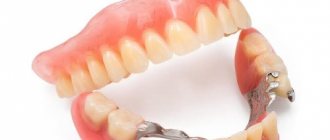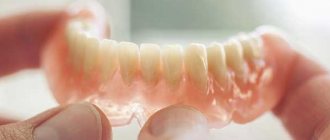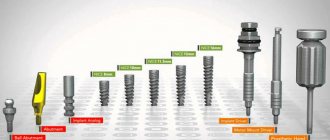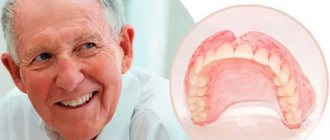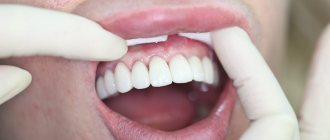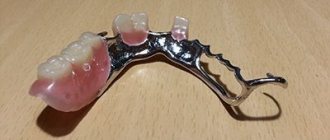Until recently, people who used removable dentures had problems securing the product in the oral cavity. Modern dentistry has many ways to restore chewing functions and the beauty of a smile. The clasp prosthesis received good recommendations from specialists. It is securely fixed on supporting teeth and crowns, allowing a person to feel comfortable and confident.
Depending on the method of creation, prostheses can be precision (made in a factory) or semi-precision (made in a laboratory based on modeling casts). Products have several types of fastening, which have their own advantages and disadvantages.
Clasp design
Such support-retaining mechanisms, which are extensions from the base of the prosthesis, are most often made of metal. This allows you to chew food efficiently and painlessly. The upper clasp fastenings do not affect diction and do not dull the sensitivity of taste buds located on the palate. The design, despite its simple structure, copes with restoring the function of chewing food better than nylon or plastic counterparts.
Design with metal clasps
Due to the destructive effect of metal on enamel, it is recommended to first install abrasion-resistant crowns on the abutment teeth.
The outer part of the clasp is visible on the surface of the teeth, but if the aesthetics of a smile is important to the patient, then the front clasps can be made of invisible polymer materials.
Polymer clasps
What are implants made of?
Commercially pure titanium is most often used for the production of implants. A distinctive feature of this high-strength material is its ability to take root without problems. The titanium rod of the implant is not rejected by the body, since it is not perceived by it as a foreign body. The only contraindication for use is individual intolerance to titanium. In this case, implants are made from other materials.
Sometimes implants are made of zirconium dioxide. The advantage is that dioxide implants do not show through the gum mucosa, which sometimes happens with titanium ones. But the main disadvantage of zirconium dioxide is the poor adherence of implants to jaw tissue and the difficulty of subsequent processing of the implant rod, therefore implants made from it are not often used in dentistry.
Attachment option (lock fastening)
One of the parts of the micro-lock (attachment) is located on the teeth enclosed in metal-ceramic crowns, and the second is on the clasp prosthesis. The mechanism snaps into place and provides a secure fit.
According to the method of fastening, locks are divided into the following types:
- intra-root, which are held on root caps;
- placed inside the product;
- soldered to the surface of the implant.
Before installing the prosthesis, the specialist cleans the enamel using ultrasound. It is important to cure all pathological phenomena in the oral cavity. A mandatory step is the installation of at least four crowns on the treated and ground abutment teeth. After completing the procedures, the structure is placed on the surface of the jaw.
Lock fastenings have a number of advantages - they are practically invisible, comfortable, and last 5-7 years or more. The design is considered high-tech and requires highly qualified specialists, but is not visible to others.
There are several types of attachments:
- hinged - joint;
- labile - shifting in any plane;
- crossbar - having a small valve;
- anchor - linked by a sphere or a button;
- semi-labile - capable of moving vertically;
- beams - a thin rod between the crowns that fits into the groove on the bottom of the prosthesis.
The choice of prosthesis is made by an orthopedist, focusing on the needs of the patient. The main mechanical impact in a design with a rigid connection is transmitted to the abutment teeth taken under the crowns. In a softer version, the load is evenly distributed over the entire jaw.
According to the level of rigidity, attachments are divided into three types:
- the toughest ones are red;
- medium hard - yellow;
- soft - green.
The locking mechanism quickly weakens, and the locking elements may need to be replaced every year and a half. The cost of repairs is about 100 rubles. The orthopedist removes worn parts and immediately installs new ones.
On telescopic crowns
This method of prosthetics is very common abroad. The supporting teeth are ground down, then metal caps are attached to them using cement. Two crowns are placed on the prosthesis frame. When put on, they are inserted on top of the caps.
The design is invisible during a conversation, evenly distributes the chewing load and is well fixed. This is the most expensive design to install.
Indications and contraindications for installation
The possibility of installing a clasp is determined during a dental examination. Removable dentures are used in the following cases:
- some molars are missing;
- it is necessary to hide multiple dental defects;
- The patient has been diagnosed with diabetes mellitus and periodontal disease;
- prominent maxillary cusps;
- flat sky;
- pathological weakness of gum capillaries;
- broken bite;
- atrophy of the alveolar processes;
- there is no possibility to install a fixed prosthesis, for example, due to severe inclination of the teeth;
- bruxism (teeth grinding);
- enamel wear is observed;
- it is necessary to restore the aesthetics of the anterior dentition.
The peculiarities of the clasps do not allow them to be installed on damaged abutment teeth affected by caries. There are other contraindications:
- small lingual-buccal space;
- inflammatory process in the area of the roots of supporting teeth;
- periodontitis;
- Lowered crowns were previously installed.
Subtleties of care
In order to extend the service life of a clasp prosthesis with locks, it is necessary to comply with the conditions of its operation. It is enough to follow simple rules:
- After each meal, rinse the structure with clean boiled water.
- Clean the denture twice a day using a toothbrush and paste, as well as a special antiseptic solution.
- Visit your dentist regularly for professional cleanings and preventive examinations.
- Avoid too hot food and drinks, chemical and mechanical effects on the prosthesis.
- If necessary, make timely repairs and corrections.
Implant rejection
If in the first days after implantation you began to experience severe, unstoppable bleeding, the gums around the implant became very swollen and inflamed, and there was acute pain that did not go away even with painkillers, then you may have experienced implant rejection. You need to see a doctor urgently. At the same time, the norm is swelling, bleeding of the gums and aching pain during the first two to three days after implantation. If these symptoms last longer, then this may also be a sign of implant rejection.
In addition, sometimes implant rejection occurs without any symptoms. If, in the subsequent period after installation of the implant, inflammation, swelling, or pain appear around it, these may be signs of infection. If measures are not taken in time, the jaw bone will become inflamed, which will also lead to the loss of the implant.
Nowadays, the survival rate of implants is 95-97%. However, the dentist should warn patients about the possibility of implant failure. He still has to study the patient's medical record to find out if he has any contraindications to installing the implant. Such contraindications most often become the cause of rejection.
Refusal of postoperative and preventive medical supervision, heavy load on the implant in the first days after installation, smoking and poor oral hygiene also cause implant rejection.
Disadvantages of the implantation method
We found that the implantation method has virtually no disadvantages, except for contraindications in some patients. The only drawback is the high cost of implants.
Leading manufacturers and cost
One of the best laboratories specializing in the manufacture of clasps is AlvaDent. The company is located on the territory of the Russian Federation; Swiss equipment is used for production, guaranteeing product quality.
Ball-shaped fasteners used for fixing clasp dentures on attachments are produced by the Italian concern Rhein-83 and the German company Bredent.
The company CENDRES & METAUX SA DENTAL, located in Switzerland, produces hinged and locking fasteners. An improved locking system was developed here, including 6 types of lock mechanism matrix and one patrix. From this organization you can order semi-labile, labile, beam and rigid spherical attachments.
The price of clasp dentures starts from 45 thousand rubles and depends on the type of product being installed, the clinic and the condition of the patient’s teeth.
Manufacturing stages
Prosthetics consists of the following stages:
- Examination and examination of the patient;
- Making a diagnosis, selecting an orthopedic design;
- Preparation of the oral cavity – professional cleaning, sanitation;
- Taking dental impressions;
- Manufacturing of structures in a dental laboratory;
- Trying on a clasp, choosing a fixation method, teeth color;
- Fixation of the finished product;
- Advice and recommendations for the patient.
Alternative options
Most orthopedists consider clasp dentures to be the optimal way to restore dentition. But at the request of the patient or existing indications, an alternative may be offered.
Nylon constructions or Acry-Free dentures:
Conditionally removable dentures fixed on several implants:
User reviews
Most patient reviews about clasp dentures are positive. But the quality of product installation always depends on the qualifications of the specialist.
I lost several teeth, and the clinic offered to install a denture with attachments. I was pleased with the result. Artificial teeth not only look great, but also do not cause discomfort.
Svetlana, 43 years old
I’ve been using a clasp prosthesis for three years and don’t take it off at night. The design is lightweight, with durable fastening. I was worried about the condition of the enamel, but there were no problems.
Mikhail, 52 years old
During the treatment of periodontal disease, I lost many teeth.
To return a beautiful smile, I decided to install a prosthesis. It was a little confusing that it was necessary to put crowns on healthy teeth, but the result is worth it. Elvira, 38 years old
What is a dental implant?
This is a device fixed into the bone tissue of the jaw and replaces a fallen or initially missing tooth. Dental implants support crowns, bridges of various lengths, removable and fixed dentures.
Several types of implants are used in dentistry, but the most widespread are root-shaped implants. These are structures consisting of a metal rod implanted into the jaw tissue and an abutment - an artificial tooth that is ground into a crown. If necessary, a gum former is installed on the implant shaft - a special metal screw with a cap. It is attached to the implant before installing the abutment and forms the gum relief to achieve an aesthetic result.
Root-shaped implants are cylindrical and screw with thread. The latter are more common, since due to the thread, the implant fuses more firmly with the jaw tissue.
